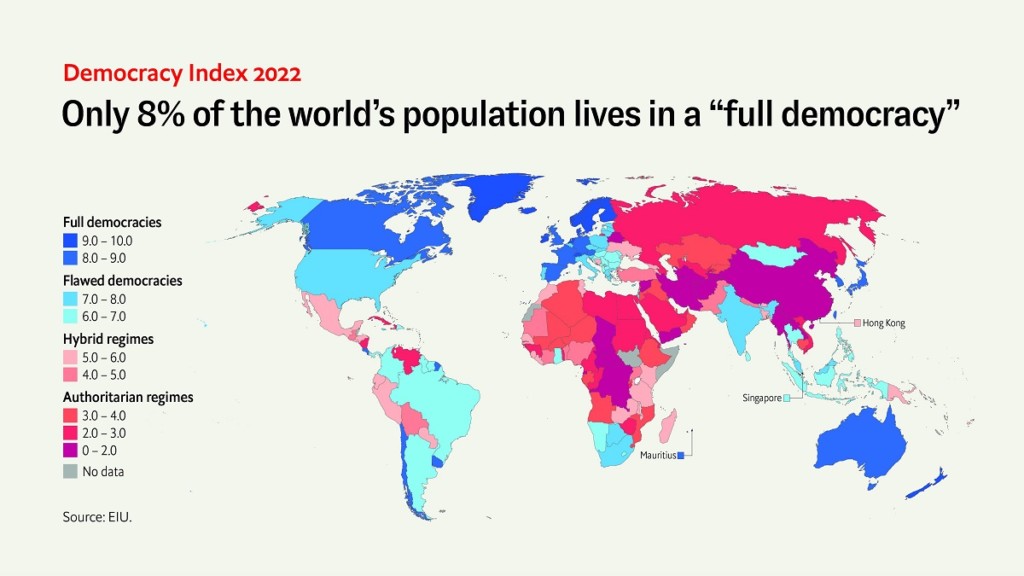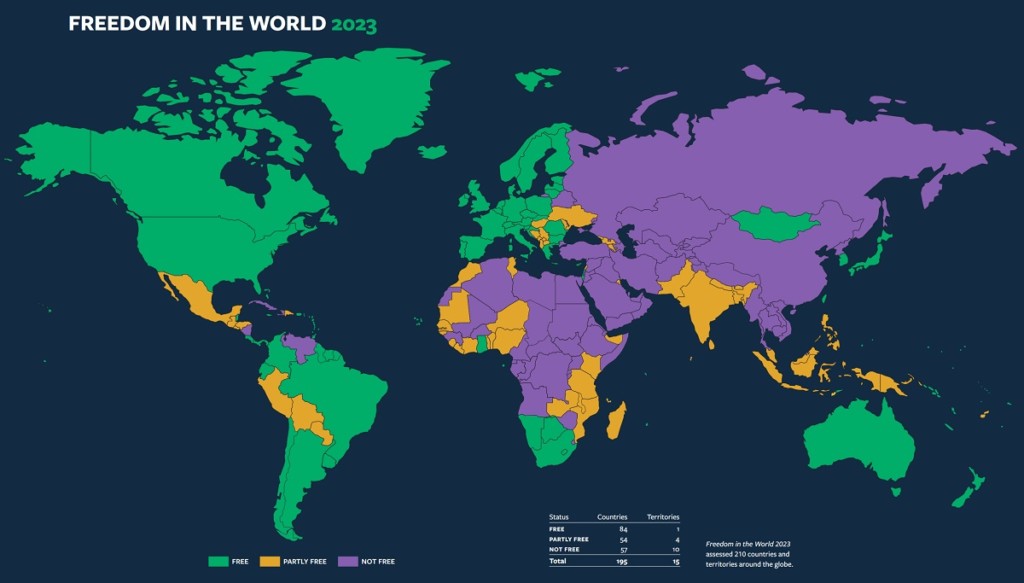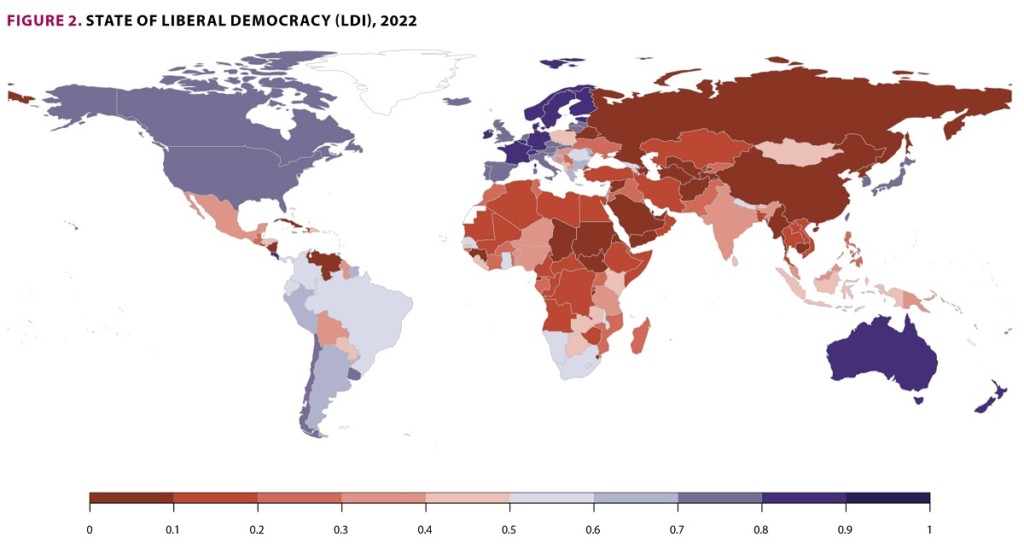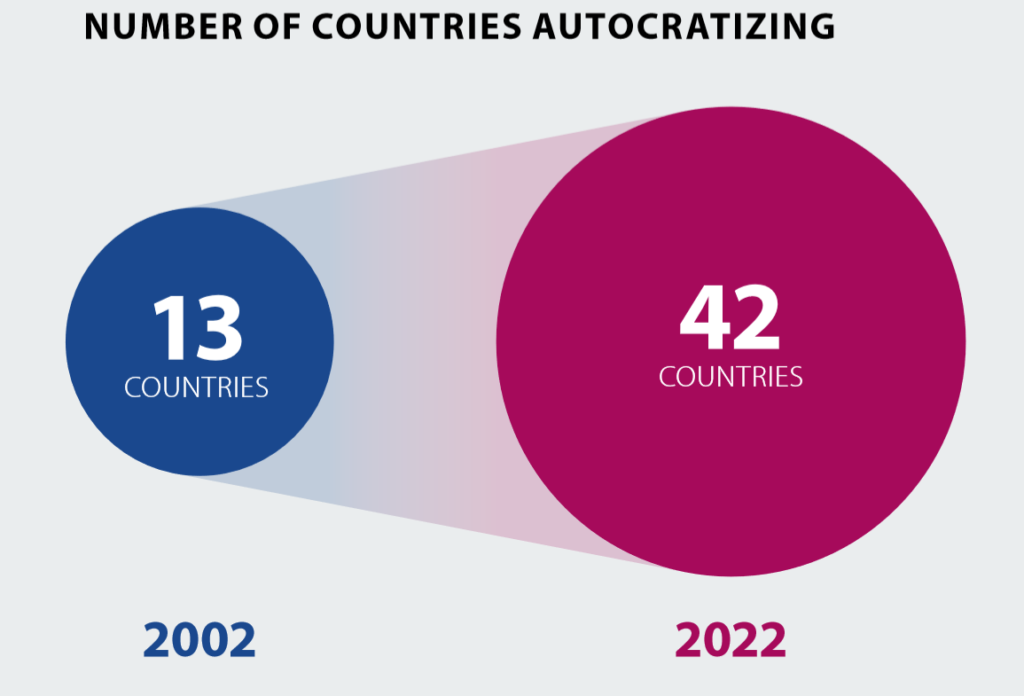This blog was written in 2023. Read our latest blog continuing the same topic!
In late 2022 and early 2023, four reports measuring the global state of democracy were published. Here are some remarks they present regarding the number of democracies:
- The number of countries moving towards authoritarianism is more than double the number moving towards democracy. (International IDEA)[1]
- 37% of the world’s population lives under authoritarian rule. (The Economist Intelligence Unit EIU)[2]
- As much as 72% of the world’s population lives in autocracies. (V-Dem Institute)[3]
- According to a report published by Freedom House[4], 43% of countries can be classified as free, a number equal to the percentage of countries classified as democracies by the EIU.
The four reports use slightly different indicators to examine the different aspects of democracy, and the way the reports classify countries into different categories to indicate the state of democracy in each country also differs between reports. International IDEA and Freedom House divide countries into three different categories, but V-Dem Institute and EIU have four categories. Therefore, their figures on, for example, the number of democracies, and thereby some of their key points of analysis, may differ. Nevertheless, the trend has been the same for several years: democracy is declining.

The crisis of democracy persists
The Global State of Democracy 2022 report by International IDEA states that half of the world’s democracies are in retreat, and that half of the non-democratic countries are becoming more repressive. The report also makes worrying findings regarding public opinion on autocratic leadership as authoritarian rule is perceived more positively than before. This is based on survey data measuring people’s attitudes towards a strong leader who does not have to care about elections or parliament.
According to International IDEA, the decline of democracy is partly due to citizens losing their faith in the effectiveness of democratic institutions. Democratic states are under pressure to better respond to people’s needs. On the other hand, various protest movements and initiatives for the development of democracy, such as constitutional reforms and citizens’ assemblies, that are underway in several places indicate efforts to reform democratic governance.
The EIU’s Democracy Index 2022 states that the global average score of countries remained unchanged from the previous year although many pandemic-related restrictions that had narrowed civil liberties were dismantled. Declines elsewhere, therefore, cancelled out the achievements of the post-COVID democratic return. It is positive, however, that in 2022 there were more countries where the state of democracy improved in comparison to the previous year. According to the EIU report, on the one hand, the number of full democracies increased slightly, but on the other hand, some countries previously labelled as flawed democracies also fell into the category of hybrid regimes.

The EIU also shows that the situation in the two major authoritarian regimes, China and Russia, took a decisive turn for the worse in 2022. In Russia, repression and censorship increased with the war of aggression against Ukraine, and China used even more draconian measures in an attempt to stop the spread of the COVID-19 virus. These findings are in line with the IDEA’s Global State of Democracy report’s observation that authoritarianism is deepening in about half of the non-democratic states.
V-Dem Institute’s Democracy Report 2023 offers many interesting infographics through which the state of democracy can be analysed. One of the key findings in the report is that 42 countries are autocratising. This is a new record – but not something to celebrate. 43% of the world’s population lives in these countries.
According to the report, 14 countries are democratizing. These countries, however, inhabit only 2% of the world’s population. The report also states that the level of democracy enjoyed by the average global citizen has declined to the level of 1986. This rather startling finding has sparked a lot of discussions. Such a dramatic decline is explained by the weight that the V-Dem data gives to the population. For example, India, whose share of the world’s population has increased and where simultaneously the state of democracy has weakened, shows how greatly the population and regime development of one state can influence the level of democracy experienced by the average citizen in the world.[5]
According to another quite striking finding in the V-Dem report, there are more closed autocracies than liberal democracies in the world for the first time in over two decades. Freedom of expression and related indicators are among the most common areas of deterioration. An interesting new perspective in V-Dem’s report is also the examination of economic power. According to the report, the global balance of economic power is increasingly shifting in favour of autocracies.
Freedom House’s Freedom in the World 2023 finds that the global level of freedom declined for the 17th consecutive year. However, in 2022, the gap between the number of countries that registered improvements and those that declined was the narrowest it has been over the 17-year period. Freedom House suggests that this might mean that democracy’s crisis is approaching a turning point. The Freedom in the World report has also identified the suppression of the freedom of expression as a key driver of global democratic decline. Protests in different countries are highlighted also in this report and interpreted as a sign of citizens’ desire for more freedom and as a reminder that authoritarian regimes are not necessarily unbeatable.

Overall, the reports confirm that the worrying trend of autocratisation continues, but glimmers of hope can be seen, for example, in civic activism and the successes of some individual countries.
Behind the broader trends
In the classification of countries, IDEA’s Global State of Democracy is more optimistic than the other reports. Of the eight countries (excluding Finland) where Demo Finland and its partners implement projects, three are democracies, three are hybrid regimes and two are authoritarian regimes, according to IDEA. On Freedom House’s three-category scale, none of these countries is considered free. Five countries are classified as partially free and three countries as not free. EIU’s Democracy Index classifies one of these countries as a flawed democracy, three countries as hybrid regimes and three as authoritarian regimes. Somalia’s data is missing from the Democracy Index. In V-Dem’s classification, three countries are electoral democracies[6], three countries are electoral autocracies[7] and two countries are closed autocracies. None of the countries is classified as a liberal democracy.

Although a single country may be categorised differently in different reports, the overall picture is very similar. Kenya, Sri Lanka and Zambia are generally classified as at least somewhat democratic, while Myanmar and Somalia in particular are placed in the most authoritarian category in all assessments.
Although the reports give a good overview of the state of democracy and their analysis is largely consistent, it is good to take a closer look at what is behind the alarming numbers. At the V-Dem report launch event, democracy expert Thomas Carothers criticised the way in which the findings are presented in the report. The comparison to 1986 wasn’t the only detail in the report that might raise a few eyebrows.
The group of autocratising countries is very diverse and includes both democracies and authoritarian states.
Does it match our perception of the world that 72% of the population lives in autocracies, given that this number includes both closed autocracies and electoral autocracies of the V-Dem classification, among them countries such as Ukraine and Nigeria? These countries are often considered democracies, albeit fragile ones. Carothers also noted that the group of autocratising countries is very diverse and includes both democracies and authoritarian states. For example, Russia and the United States both belong to this group.
This critique is well-founded, and it is worth examining the reports more closely. Yet, it should be noted that any decline in any part of democracy is a step in the wrong direction, and can, even in a strong democracy, mark the beginning of democratic backsliding. Therefore, even the smallest decline should not be overlooked, and the label of an autocratising country can be a justified wake-up call.

Even established democracies cannot take their situation for granted, and therefore Demo Finland also works in Finland. Finland has a long tradition of, for example, co-operation between parties and women’s participation in society, but this is not carved in stone. Backsliding is a threat not only to weak democracies but also to established ones. Especially in terms of democratic participation, Finland has a lot to improve. For example, Finland lags behind other Nordic countries in voting activity in elections.
Democracy must be supported in all situations
With the help of the annual reports and the data tools that IDEA and V-Dem provide, it is possible to follow the development of individual countries. Among the countries where Demo Finland and its partners implement projects, Myanmar and Tunisia are examples of countries that have experienced both democratisation and more recently autocratisation in a fairly short time frame. In both countries, citizens still support democracy. However, there are different explanations as to why these countries are listed among the top autocratising countries in several reports.
In Myanmar, there was a ten-year period of democratisation before the military coup in 2021, but even during this period, the military had constitutional power. This guaranteed the military a firm grip on the democratisation process and made it possible for the military to steer the process in the desired direction. On the contrary, in Tunisia, citizens have been dissatisfied with the fact that democratic development has not brought immediate economic improvements or eliminated corruption. Meanwhile, the formation of a coalition government has proved difficult. Eventually, the president elected from outside the party field began to concentrate power on himself, which led to a dramatic drop in democracy indicators.
It takes longer than a decade to build a successful democracy.
Tunisians have understandably been frustrated that democratisation did not immediately bring solutions to social and economic problems. In Finland, for example, representative institutions and consensus-seeking politics have a long history. Tunisia’s example shows how challenging it is to develop a multi-party democracy from a very different starting point. The Arab Spring and the subsequent development of democracy in Tunisia created a lot of expectations, but it takes longer than a decade to build a successful democracy.
There are also positive developments in the democracy reports. In the V-Dem report, Zambia has been included in the list of eight countries where the state of democracy has improved after an autocratic period. Both Zambia and Kenya have been ranked among the countries that have shown the most improvement in the state of democracy in several reports. In Kenya, the positive assessments were affected especially by the August 2022 elections, which, for example, according to EU election observers[8], went largely peacefully and in a democratic manner despite challenges. Zambia and Kenya are examples of contexts where there are opportunities for the continuation of positive democratic development. Supporting democracy is then essential in order to strengthen it.
No country can be democratised from the outside.
Quick wins cannot be achieved with democracy support in countries that are classified as authoritarian. No country can be democratised from the outside, only its own citizens can do it. However, we can provide support by strengthening the competence and skills of democratic actors and enhancing dialogue between them. These tools are vital functions of democracy support in both young democracies and non-democratic contexts as they ensure that when democratic openings occur, there are actors with the capacity to seize the opportunity and build a more democratic society.
Even though the message of the democracy reports has been dismal in recent years, democratic movements and protests against authoritarian regimes have not gone unnoticed. There is a demand for democracy. There is also hope that as the long-term support for democracy continues, we will be able to read a more positive message about the state of democracy around the world in the near future.
[1] International IDEA 2022. Global State of Democracy Report 2022: Forging Social Contracts in a Time of Discontent.
[2] The Economist Intelligence Unit 2023. Democracy Index 2022.
[3] V-Dem Institute 2023. Democracy Report 2023: Defiance in the Face of Autocratization.
[4] Freedom House 2023. Freedom in the World 2023: Marking 50 years in the Struggle for Democracy.
[5] See Justin Kempf 16.3.2023. Democracy Regressed Back to 1986? Democracy Paradox blog.
[6] According to V-Dem, electoral democracy has the following attributes: Multiparty elections for the executive are free and fair; satisfactory degrees of suffrage, freedom of expression, freedom of association. However, there are some limitations to civil liberties and rule of law.
[7] According to V-Dem, electoral autocracy has the following attributes: Multiparty elections for the executive exist; insufficient levels of fundamental requisites such as freedom of expression and association, and free and fair elections.
[8] European Union Election Observation Mission 27.10.2022. Kenya 2022: Final Report.
—
The views expressed are those of the author and do not necessarily reflect the views of Demo Finland.

